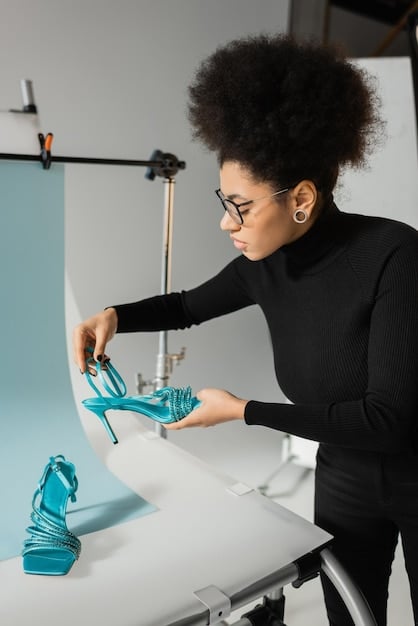Future Footwear: Top Sneaker Trends to Watch

Anúncios
The future of footwear is being shaped by cutting-edge innovations and shifting consumer preferences, driving the emergence of sustainable, technologically integrated, and personalized sneaker designs that redefine both form and function.
The world of sneakers is in a perpetual state of evolution, constantly pushing boundaries of design, technology, and sustainability. As we move further into the 21st century, the future of footwear: innovative sneaker trends to watch promises not just new styles, but a complete reimagining of what a shoe can be.
The Intersection of Sustainability and Style
The global consciousness around environmental impact has fundamentally reshaped virtually every industry, and footwear is no exception. Consumers are increasingly demanding products that not only look good and perform well but also align with their values concerning ecological responsibility. This shift has propelled sustainability from a niche concern to a mainstream imperative within the sneaker industry, driving innovation in materials, manufacturing processes, and end-of-life solutions.
This growing emphasis on sustainability is leading brands to explore novel approaches, moving beyond superficial “greenwashing” to genuine, systemic changes. The goal is to minimize waste, reduce carbon footprints, and create products that are circular in nature, meaning they can be recycled or biodegraded without harming the planet. The materials being developed are revolutionary, often repurposing what was once considered waste into high-performance components.
Eco-conscious materials redefining design
The backbone of sustainable footwear lies in the materials chosen. Traditional sneaker production often relies on synthetic fabrics, rubbers, and glues derived from fossil fuels, which have significant environmental impacts. The future, however, is being built on alternative, eco-friendly materials that offer both performance and a reduced footprint.
* **Recycled Plastics and Ocean Waste:** Many brands are now transforming discarded plastic bottles, fishing nets, and other ocean debris into high-quality yarns and components for uppers, laces, and even midsoles. This not only diverts waste from landfills and oceans but also reduces the need for virgin plastic production.
* **Bio-based and Plant-derived Materials:** Innovations in biotechnology are leading to materials like mushroom leather (Mylo), algae-based foams, and natural rubbers. These alternatives offer comparable properties to traditional materials but are renewable and biodegradable, significantly lowering the environmental burden.
* **Recycled Rubber and Foam:** Soles and cushioning systems are increasingly being made from recycled rubber scraps from tire manufacturing or post-consumer sneaker waste. This circular approach minimizes waste and energy consumption in production.
Minimizing Environmental Footprint in Production
Beyond material selection, the manufacturing process itself is undergoing a green transformation. Brands are adopting practices that reduce water and energy consumption, and minimize chemical use.
* **Waterless Dyeing Techniques:** Traditional textile dyeing is extremely water-intensive. New technologies, such as dope dyeing (adding color pigments to the polymer solution before extrusion) or digital printing, drastically reduce water usage and chemical run-off.
* **Automated and Localized Manufacturing:** Investing in robotics and automation can optimize material usage and reduce waste. Furthermore, localized production closer to consumption markets can cut down on transportation emissions associated with global supply chains.
* **Modular Design for Repair and Recycling:** Designing sneakers with components that can be easily separated or replaced extends the product’s lifespan and facilitates recycling. This moves away from the “fast fashion” mentality towards a more circular economy.
The journey towards fully sustainable footwear is complex, but the industry’s commitment is clear. From the farms growing renewable resources to the factories implementing eco-conscious processes, every step is being re-evaluated. The aim is to create sneakers that feel good on foot and good for the planet, demonstrating that high-performance style and environmental responsibility can, and must, coexist. This holistic rethinking promises a future where every step leaves a lighter print.
Wearable Technology and Smart Sneakers
The convergence of fashion and technology is revolutionizing the footwear industry, transforming sneakers from simple accessories into sophisticated wearable devices. This evolution goes far beyond aesthetic enhancements, embedding intelligent features directly into the shoe to offer unparalleled insights, improved performance, and novel interactive experiences. These innovations are poised to redefine how we interact with our footwear and how our footwear interacts with the world around us.
The integration of technology into sneakers opens up a new realm of possibilities, moving from passive items to active participants in our daily lives. From monitoring our physical well-being to enhancing athletic prowess, smart sneakers are becoming an indispensable tool for health enthusiasts, professional athletes, and tech-savvy individuals alike. The challenge lies in seamlessly blending these advanced functionalities without compromising comfort, durability, or style.
Performance-enhancing sensors and connectivity
At the heart of smart sneakers are advanced sensor technologies capable of collecting a wealth of data about movement, gait, and impact. These sensors, often discreetly integrated into the sole or upper, provide real-time feedback that can be invaluable for training and injury prevention.
* **Gait Analysis and Biomechanics:** Sensors can meticulously track foot strike patterns, pronation, and supination, offering detailed insights into an individual’s running or walking mechanics. This data can help optimize stride efficiency, improve balance, and identify potential issues that could lead to injury.
* **Impact Absorption and Cushioning:** Integrating pressure sensors allows sneakers to monitor force distribution and impact levels during various activities. This information can be used to dynamically adjust cushioning or provide alerts if impact forces are consistently too high, indicating a need for technique adjustment or different footwear.
* **Speed, Distance, and Cadence Tracking:** While many smartwatches offer these metrics, direct integration into the shoe provides more accurate and consistent data, unaffected by arm swing or other external factors. This is particularly beneficial for runners and athletes looking for precise performance tracking.
Integration with health and fitness ecosystems
The true power of smart sneakers emerges when their data is integrated with broader health and fitness platforms. This connectivity creates a holistic view of an individual’s physical activity and well-being.
* **Smartphone and App Compatibility:** Most smart sneakers pair seamlessly with dedicated mobile applications, allowing users to view their data, set goals, receive personalized coaching, and track their progress over time. These apps often provide visual dashboards, historical data, and even gamified challenges.
* **Smartwatch and Wearable Synergy:** Data from smart sneakers can complement information gathered by smartwatches, heart rate monitors, and other wearables, creating a comprehensive fitness profile. This allows for a deeper understanding of overall health, recovery, and training effectiveness.
* **Personalized Training and Rehabilitation:** For athletes, the detailed biomechanical data can be used by coaches or physical therapists to develop highly customized training plans or rehabilitation exercises, addressing specific weaknesses and optimizing performance safely.
The journey of smart sneakers is just beginning, with continuous advancements in miniaturization, battery life, and data processing capabilities. As these technologies mature, we can expect sneakers to become even more intuitive, predictive, and integrated into our digital lives, blurring the lines between fashion, function, and cutting-edge technology. The ultimate goal is to empower users with actionable insights, transforming every step into a data point for a healthier, more optimized life.

Modular Design and Customization
In an increasingly personalized world, the concept of a one-size-fits-all sneaker is becoming outdated. Consumers are yearning for products that reflect their unique identity and needs, prompting footwear brands to embrace modularity and customization. This trend is not merely about aesthetic choice; it’s about empowering individuals to co-create their ideal shoe, from performance attributes to stylistic flourishes.
Modular design, at its core, allows for the interchangeability of components, transforming a single pair of sneakers into a dynamic system that can adapt to different activities, preferences, or even repair needs. This shift moves away from mass production uniformity towards bespoke individuality, offering a sustainable alternative to continuously buying new shoes. The ability to customize provides a deeper connection between the user and their footwear, fostering a sense of ownership and personal expression.
Building blocks for personalized performance
The modular approach enables consumers to tailor specific elements of their sneakers to enhance performance, comfort, or simply to express their personal style. This is a significant leap beyond traditional sizing and color options.
* **Interchangeable Midsoles:** Different running surfaces or activities require varying levels of cushioning and responsiveness. Modular designs could allow users to swap out midsoles – perhaps a firmer one for track workouts and a softer one for long-distance road running – optimizing performance without needing multiple pairs of shoes.
* **Configurable Uppers and Lacing Systems:** The upper part of the shoe, which provides containment and breathability, could also become modular. Users might choose different materials (e.g., breathable mesh for summer, water-resistant knit for winter) or lacing configurations to achieve a more supportive or flexible fit.
* **Outsole Traction Patterns:** Depending on the terrain or sport, different outsole patterns and rubber compounds are optimal for grip. Modular outsoles would allow consumers to switch between, for example, a road running tread, a trail running lug pattern, or a basketball specific grip, for varied conditions.
The rise of co-creation and bespoke footwear
Beyond simply swapping components, the future of footwear customization involves a deeper level of co-creation between the consumer and the brand. This empowers individuals to design shoes that are truly unique.
* **Virtual Design Platforms:** Advanced 3D design software and augmented reality (AR) tools allow consumers to visually customize every aspect of their sneaker online, from color palettes and material textures to unique graphic placements. Real-time rendering provides a realistic preview of the final product.
* **Additive Manufacturing (3D Printing):** This technology is a game-changer for bespoke footwear. It allows for the creation of intricate, custom-fit components – like unique lattice structures for midsoles – based on individual foot scans. This enables unprecedented levels of personalized comfort and performance.
* **Small-batch and On-demand Production:** The demand for highly customized items naturally leads to smaller production runs or on-demand manufacturing. This reduces waste associated with mass production and allows brands to respond more agilely to individual consumer demands, fostering a closer relationship with their customer base.
The trajectory towards modularity and customization highlights a shift in consumer expectations: from passively receiving products to actively participating in their creation. This not only fuels personal expression but also encourages a more thoughtful consumption cycle, where items are valued for their adaptability and longevity rather than disposable trends. The future suggests a sneaker wardrobe that evolves with you, piece by piece, rather than being constantly replaced.
Retro-Futurism and Nostalgic Revivals
While innovation propels the sneaker industry forward, there’s a powerful counter-current drawing inspiration from the past: retro-futurism and the continuous revival of nostalgic designs. This trend isn’t just about re-releasing old favorites; it’s about reinterpreting classic silhouettes with modern twists, blending iconic aesthetics with contemporary technology and materials. It’s a testament to the enduring appeal of certain designs and a recognition that the past holds valuable lessons for the future of footwear.
Retro-futurism captures the essence of how past generations imagined the future, resulting in designs that feel both familiar and visionary. This blend creates a unique aesthetic that resonates with consumers who appreciate heritage while embracing progress. Nostalgic revivals, on the other hand, tap into collective memory, bringing back beloved styles that evoke a sense of comfort and authenticity, often with updated performance capabilities to meet modern demands.
Blending iconic past with cutting-edge present
The fusion of retro aesthetics with cutting-edge technology is a defining characteristic of this trend. It’s about taking what worked well and making it even better, more comfortable, and more durable.
* **Re-engineered Classics:** Brands are taking popular silhouettes from their archives and rebuilding them using advanced construction techniques, lighter materials, and superior cushioning systems. The exterior might look familiar, but the internal mechanics are vastly improved, offering modern comfort with vintage appeal.
* **Futuristic Material Application:** Imagine a classic 80s running shoe reimagined with an upper woven from recycled ocean plastic, or a sole embedded with bio-printed components. This application of new materials to old forms creates unexpected textures and sustainability stories, bridging eras.
* **Exaggerated Proportions and “Chunky” Design:** The chunky sneaker trend, a strong element of retro-futurism, takes cues from 90s athletic footwear characterized by oversized soles and bold lines. These designs often incorporate visible air units or multi-layered soles, emphasizing both cushioning and a distinct aesthetic.
The cultural impact of sneaker heritage
Sneaker culture is deeply intertwined with history, and the continuous return to classic designs reflects this profound connection. These revivals are not just fashion statements; they are cultural touchstones.
* **Storytelling and Authenticity:** Each iconic retro sneaker carries a story – of athletic achievement, street style evolution, or cultural movements. Brands leverage this narrative, offering consumers a piece of history that they can connect with and incorporate into their personal identity.
* **Intergenerational Appeal:** Nostalgia appeals to older generations who remember these styles from their youth, while their renewed popularity introduces them to younger consumers who appreciate their unique aesthetics and historical significance, often seeing them as “new again.”
* **Limited Editions and Collaborations:** To amplify hype and exclusivity, brands often release limited-edition retro revivals or collaborate with artists, designers, or other cultural figures. These collaborations inject fresh perspectives into classic designs, making them highly coveted collector’s items.
The retro-futurism and nostalgic revival trend underscore the cyclical nature of fashion, proving that great design is timeless. By respectfully reinterpreting their heritage through a modern lens, sneaker brands are not only satisfying consumer demand for authenticity but also subtly influencing the direction of future design, creating a rich tapestry where past and future seamlessly intertwine.
Gender-Neutral and Inclusive Design
The boundaries between traditional gender expressions in fashion are increasingly dissolving, leading to a significant shift in footwear design. The movement towards gender-neutral and inclusive designs reflects a broader societal recognition of diverse identities and the rejection of narrow, binary classifications. This trend is liberating both designers and consumers, fostering creativity and accessibility in a way that traditional categorization often limits.
For too long, footwear has been segmented by highly specific (and often arbitrary) gender distinctions, leading to limitations in style, sizing, and color options for large segments of the population. The future, however, champions universality, creating sneakers that are designed to be worn and loved by anyone, regardless of their gender identity. This is not just about making products unisex; it’s about designing with an inherent understanding of diverse human needs and preferences from the outset.
Breaking down traditional gender barriers
The core of this trend involves dismantling the preconceived notions of what constitutes “male” or “female” footwear, focusing instead on universal appeal and functional relevance.
* **Universal Sizing and Fit:** Moving beyond “men’s” and “women’s” sizes, brands are exploring more inclusive sizing systems that accommodate a broader range of foot shapes and sizes. This might involve adopting European sizing standards or developing unique alpha-numeric systems that do not implicitly assign gender.
* **Palette and Aesthetic Freedom:** Traditional gender-coded color palettes (e.g., pinks and pastels for women, muted tones for men) are being abandoned in favor of a wider, more fluid spectrum. Designs are embracing versatility, with silhouettes and details that appeal across the board, moving away from overtly masculine or feminine styling.
* **Functional Design First:** Prioritizing comfort, performance, and durability over gendered aesthetics leads to designs that genuinely serve the wearer. This means focusing on ergonomic considerations, material performance, and innovative construction that benefits all feet, rather than adhering to outdated beauty standards.
Designing for a diverse consumer base
True inclusivity extends beyond gender to embrace body diversity, cultural backgrounds, and different abilities, ensuring that sneakers are accessible and desirable for everyone.
* **Adaptive Footwear:** For individuals with disabilities, adaptive sneakers are gaining prominence. These designs incorporate features like magnetic closures, larger openings, or easy-on/easy-off mechanisms, making it simpler for people with limited dexterity to put on and take off shoes independently.
* **Culturally Responsive Designs:** Brands are increasingly collaborating with artists and designers from diverse cultural backgrounds to create sneakers that resonate with a wider audience. This involves incorporating traditional patterns, motifs, or artistic expressions in a respectful and authentic manner.
* **Personal Expression Over Prescription:** The ultimate goal is to empower individuals to choose footwear that genuinely expresses their identity without feeling constrained by societal norms. This encourages a more personal and authentic approach to style, reflecting the fluidity and diversity of modern identity.
The shift towards gender-neutral and inclusive sneaker design is more than a fleeting trend; it represents a fundamental change in how the industry views its consumers. By consciously designing for everyone, brands are not only opening up new markets but also contributing to a more equitable and expressive fashion landscape where personal style is celebrated in all its forms.

Automation and Advanced Manufacturing
The traditional methods of sneaker production, often labor-intensive and geographically dispersed, are rapidly being transformed by automation and advanced manufacturing technologies. This paradigm shift promises to revolutionize efficiency, reduce waste, and enhance the precision and customization capabilities within the footwear industry. By embracing robotics, artificial intelligence, and digital fabrication, brands are not just speeding up production; they are fundamentally reshaping the entire supply chain.
The allure of automation lies in its ability to deliver consistency, scale, and cost-effectiveness that human labor alone cannot achieve. Moreover, it addresses growing concerns about ethical labor practices and environmental impact by enabling localized, more sustainable production models. This move towards highly automated factories, or “dark factories” where lights are rarely needed due to robot operation, represents a significant leap forward in manufacturing capacity and innovation.
Robots on the production line
Robotics are no longer confined to heavy industries; they are increasingly becoming integral to the delicate and intricate process of sneaker manufacturing.
* **Automated Stitching and Assembly:** Robots equipped with advanced vision systems can precisely cut and stitch materials, perform complex assembly tasks, and even glue components with unparalleled accuracy. This minimizes errors, enhances quality, and significantly speeds up production cycles.
* **Material Handling and Logistics:** Automated guided vehicles (AGVs) and robotic arms efficiently transport materials between workstations, manage inventory, and package finished products. This streamlined logistics system reduces human error, improves safety, and optimizes factory floor space.
* **Quality Control and Inspection:** AI-powered cameras and sensors can conduct rapid, meticulous inspections for defects, ensuring that every sneaker meets stringent quality standards before it leaves the factory. This proactive approach reduces the likelihood of costly recalls and enhances brand reputation.
Digital design and rapid prototyping
Before a sneaker even reaches the physical production line, digital technologies are accelerating the design and development process, enabling unprecedented levels of iteration and innovation.
* **3D Design Software:** Designers are leveraging sophisticated 3D modeling tools to create virtual prototypes, experiment with different materials and colorways, and refine designs with remarkable speed. This reduces the need for expensive physical samples and speeds up decision-making.
* **Virtual Reality (VR) and Augmented Reality (AR) Prototyping:** Designers can step into immersive VR environments to visualize and manipulate sneaker designs in three dimensions, or use AR to overlay virtual models onto real-world environments. This allows for more intuitive design exploration and client presentations.
* **Additive Manufacturing (3D Printing) for Components:** Beyond full sneaker production, 3D printing is invaluable for rapid prototyping individual components like outsoles, midsoles, or specialized lugs. This allows designers to quickly test various geometries and material properties before committing to mass production.
The ongoing advancements in automation and manufacturing signify a future where sneakers can be produced more efficiently, sustainably, and with greater precision than ever before. This shifts geographical production landscapes, potentially bringing manufacturing closer to consumer markets, reducing lead times, and responding more flexibly to market demands. The integration of advanced technologies at every stage heralds a new era of footwear production defined by agility and innovation.
The Rise of Hyper-Personalization Beyond Customization
While customization allows consumers to choose from predefined options, hyper-personalization takes this concept to an entirely new level. It leverages data and advanced analytics to create products that are uniquely tailored to an individual’s biomechanics, lifestyle, and aesthetic preferences without requiring direct input on every detail. This is the ultimate bespoke experience, driven by technology that understands the wearer deeply.
Hyper-personalization is about moving from “what you choose” to “what you need” before you even know it. It combines insights from wearable tech, AI algorithms, and advanced manufacturing to deliver a shoe that fits not just the foot, but the way a person moves, the activities they engage in, and their individual style profile. This is the pinnacle of personalized design, setting a new standard for consumer expectation and product performance.
Data-driven design for individual needs
The foundation of hyper-personalization lies in collecting and interpreting vast amounts of individual-specific data, using it to inform every aspect of shoe design.
* **Biometric Foot Scanning:** Advanced 3D foot scanners can capture thousands of data points on foot length, width, arch height, instep volume, and pressure points. This incredibly detailed information allows for the creation of lasts (shoe molds) that are perfectly matched to an individual’s unique foot shape, ensuring an unparalleled fit.
* **Gait and Activity Analysis:** Data from smart insoles, wearable sensors, or even high-speed cameras can analyze an individual’s gait cycle, pronation patterns, and impact forces during various activities. This information can then be used to precisely tune cushioning, support structures, and sole geometries for optimal performance and injury prevention.
* **AI-powered Material Selection:** Based on a user’s activity levels, climate, and desired breathability or support, AI algorithms can recommend or even design optimal material combinations for the upper, lining, and other components, ensuring the shoe performs perfectly for the wearer’s specific needs.
On-demand manufacturing for unique products
Once the hyper-personalized design is complete, advanced manufacturing techniques like 3D printing become crucial for bringing these unique creations to life efficiently.
* **Direct Digital Manufacturing:** Instead of traditional molds and mass production lines, 3D printing allows for the direct creation of unique shoe components (like midsoles with specific lattice structures or customized outsoles) from the digital design file. This eliminates waste and significantly reduces lead times for bespoke items.
* **Robotic Assembly of Unique Components:** While main components might be 3D printed, the assembly of various custom parts (e.g., a personalized upper attached to a bespoke sole) can still be handled by agile robots that can switch between different designs on the fly, enabling true on-demand, single-unit production.
* **Micro-scale Personalization in Existing Models:** Even for mass-produced models, hyper-personalization can apply to smaller elements. For example, a customer might receive a standard model, but the insole could be 3D printed specifically for their arch support needs based on their foot scan, providing a subtle but significant performance enhancement.
Hyper-personalization represents the zenith of the consumer-centric model in footwear. It promises a future where every sneaker is not just worn, but truly lived in, molded precisely to the contours and demands of its owner. This highly individualized approach reshapes the relationship between product and consumer, moving towards a truly symbiotic fit that was once only dreamed of.
The Metaverse, NFTs, and Digital Footwear
The burgeoning world of the metaverse, non-fungible tokens (NFTs), and digital fashion is introducing a fascinating new frontier for the footwear industry. Beyond physical sneakers, brands are now exploring virtual realms to establish their presence, engage with consumers in novel ways, and unlock entirely new revenue streams. This digital dimension offers unparalleled creative freedom, sustainability benefits, and a new form of ownership for a generation comfortable blurring the lines between the physical and virtual.
Digital footwear exists as virtual assets that can be “worn” by avatars in online games, social platforms, or metaverses, or simply collected as unique digital art. NFTs, specifically, provide proof of ownership and authenticity for these digital items on the blockchain, granting them rarity and value similar to their physical counterparts. This brave new world is not just a passing fad; it represents a significant behavioral shift towards digital identity and ownership.
Designing for a virtual reality
Creating sneakers for the metaverse requires a different design philosophy than for physical products, embracing the limitless possibilities of a digital canvas.
* **Exaggerated and Impossible Designs:** Freed from the constraints of physics and material limitations, digital sneakers can feature impossible geometries, glowing elements, transforming parts, or textures that shimmer and shift. This allows designers to push creative boundaries far beyond what’s practical in the physical world.
* **Interactive and Dynamic Elements:** Digital footwear can be programmed to react to a user’s movements, change color with mood, or even display real-time data. This interactivity adds a layer of engagement that physical shoes simply cannot offer.
* **Cross-platform Compatibility:** A key challenge and opportunity is designing digital sneakers that can be seamlessly transferred and “worn” across various metaverse platforms, ensuring interoperability and maximizing their utility and desirability within the broader digital ecosystem.
NFTs as proof of ownership and authenticity
NFTs are central to the digital footwear trend, providing a secure and verifiable means of ownership for virtual assets.
* **Digital Collectibles and Rarity:** Just like rare physical sneakers, NFTs allow brands to create limited-edition digital collectibles. The blockchain verifies the scarcity and authenticity of these items, giving them value in the same way a physical collectible gains value from its rarity and demonstrable provenance.
* **Utility in the Metaverse:** Beyond static collectibles, digital sneaker NFTs can offer utility within specific metaverse environments. This could include access to exclusive virtual events, boosted in-game abilities for avatars wearing them, or even a pathway to redeem a physical version of the digital shoe.
* **Bridge to Physical Products (Phygital):** Some brands are experimenting with “phygital” drops, where purchasing a physical sneaker grants ownership of an NFT version, or vice-versa. This links the tangible and intangible worlds, creating a richer experience for collectors and fans.
The metaverse and NFTs are not replacing physical footwear but rather expanding its definition. They offer brands new avenues for storytelling, community building, and consumer engagement, inviting sneaker enthusiasts to build a digital wardrobe as vibrant and expressive as their physical one. This convergence represents a major next step in the evolution of footwear consumption and ownership.
| Key Trend | Brief Description |
|---|---|
| 🌱 Sustainable Materials | Focus on eco-friendly materials like recycled plastics, bio-based sources, and waterless dyeing techniques to reduce environmental impact. |
| ⚡ Smart Tech Integration | Integration of sensors for performance tracking, gait analysis, and connectivity with health/fitness apps, turning shoes into wearables. |
| 🧩 Modular & Customization | Enabling interchangeable components and co-creation platforms for personalized fit, performance, and aesthetic expression. |
| 🌌 Digital & Metaverse | Expansion into virtual footwear, NFTs, and digital collectibles, offering new creative expression and ownership in online realms. |
Frequently Asked Questions About Sneaker Innovation
Sustainability is a core driver, influencing everything from material sourcing to manufacturing processes. Brands are increasingly using recycled, bio-based, and plant-derived materials, alongside water-saving dyeing techniques and modular designs for better recyclability. This shift reflects growing consumer demand for eco-conscious products. Products are designed for longevity and minimal environmental footprint.
Smart technology integration in sneakers involves embedding sensors to track performance metrics like gait, impact, speed, and distance. These “smart sneakers” connect to apps for personalized feedback, training insights, and health monitoring. They aim to provide highly accurate data directly from the foot, enhancing athletic performance and injury prevention through real-time analysis.
Hyper-personalization goes beyond simple customization by leveraging biometric data, gait analysis, and AI to create shoes uniquely tailored to an individual’s specific foot shape, gait mechanics, and activity needs. This involves advanced 3D scanning and 3D printing technologies to produce components that offer unparalleled fit, comfort, and performance designed just for the wearer.
No, digital sneakers and NFTs are not replacing physical footwear but rather expanding the market into the virtual realm. They offer new avenues for creative expression, ownership, and brand engagement within metaverses and online platforms. Digital shoes can be collected, used by avatars, or linked to physical products, creating a “phygital” experience that complements, rather than replaces, traditional consumption.
Automation significantly influences sneaker manufacturing by enhancing efficiency, precision, and sustainability. Robots perform intricate tasks like stitching and assembly, while 3D printing accelerates prototyping and enables on-demand, customized production. This reduces labor costs, minimizes waste, and allows for quicker response to market demands, potentially localizing production and shortening supply chains.
Conclusion
The future of footwear is a dynamic landscape shaped by an accelerating pace of innovation, consumer demand for authenticity, and a growing commitment to planetary health. From sustainable materials and smart technologies to modular designs and the expansion into digital realms, sneakers are evolving beyond mere accessories into highly functional, personalized, and environmentally conscious products. This exciting transformation reflects a broader societal shift towards thoughtful consumption and an appreciation for items that seamlessly blend performance, ethics, and unparalleled style.





